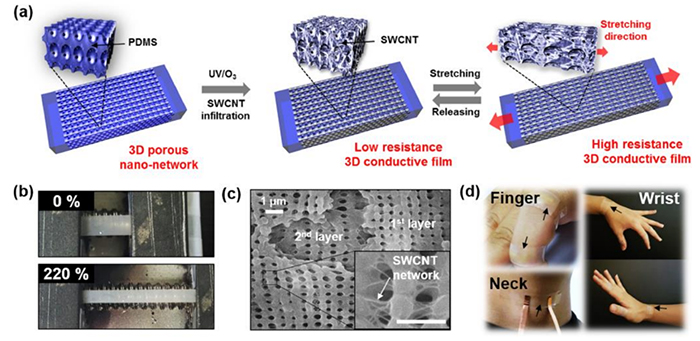As a research project of the Global Frontier Program – KAIST Advanced Battery Center, Professor Seokwoo Jeon’s research team is working on the development of a stretchable electrode system with various three-dimensional (3D) nanostructures using a scalable lithographic technique. The project was started in 2016 to develop and optimize a stretchable and conductive 3D nanostructure as a wearable strain gauge for detecting human motions. The real-time and sensitive detection of human motion (i.e., phonation and joint movement) is of great importance for ubiquitous healthcare technology. In the past decade, there have been numerous efforts to develop body-attachable human−machine interfaces based on flexible and stretchable conductors. Among these developments, a resistance-mode wearable strain gauge has been showing great potential for commercialization due to its reliability and simplicity. To achieve a high-quality resistance-mode strain gauge, three major aspects of technical development should be satisfied: (1) improving sensitivity (i.e., a gauge factor over 200%), (2) widening the working strain range, and (3) retaining the intrinsic piezoresistive properties without severe performance degradation after repeated usage.
Herein, we demonstrate a highly sensitive and stretchable strain gauge consisting of a 3D continuous percolation network of single-walled carbon nanotubes (SWCNTs) formed along a 3D nanostructured porous elastomer polydimethylsiloxane (PDMS). The uniformly interconnected 3D nanostructure can greatly improve the stretchability (>200%) of the sensor. In addition, the structure enables efficient electrical percolation of conductive networks even at an extremely low concentration of SWCNTs (0.9 vol%), leading to dramatically increased sensitivity.

The main contribution of this work is the first development of the solid-state, conductive 3D nanonetwork with optimal percolations that can maximize the performance of resistive strain sensors, as demonstrated by the highest gauge factor of ∼134 among CNT-based sensors reported to date. To achieve this, we have solved the dispersion problem of CNTs in the 3D nanostructured elastomeric matrix by surface treatment even at an extremely low concentration of CNTs (<1 vol %). Therefore, the solid-state, conductive 3D nanonetwork suggests a possible strategy for applications that require high sensitivity, such as capturing delicate phonations and dynamic detection of human joint motions.
Jeon, Seokwoo (Dept. of Materials Science and Engineering)
Homepage: http://fdml.kaist.ac.kr
E-mail: jeon39@kaist.ac.kr, roy0202@kaist.ac.kr






